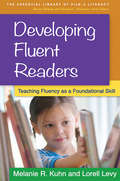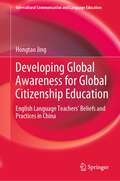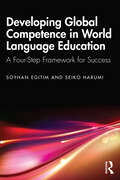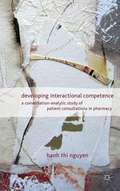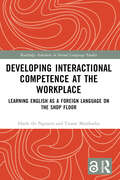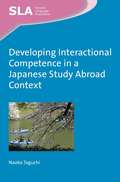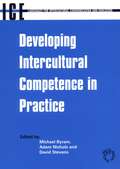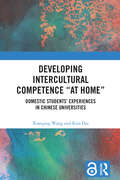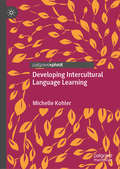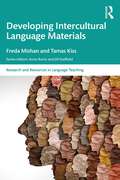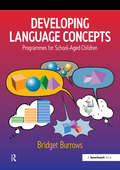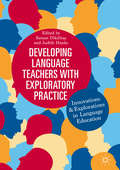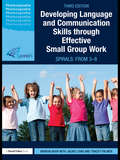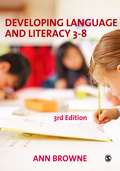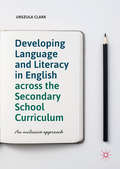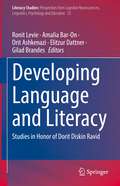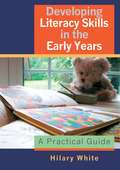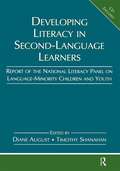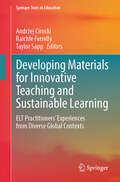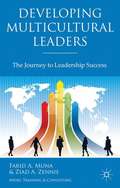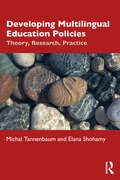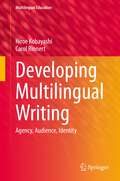- Table View
- List View
Developing Fluent Readers: Teaching Fluency as a Foundational Skill (The Essential Library of PreK-2 Literacy)
by Lorell Levy Melanie R. KuhnViewing fluency as a bridge between foundational skills and open-ended learning, this book guides teachers through effective instruction and assessment of fluent reading skills in the primary grades. Fluency's relationship to phonological awareness, phonics, and print concepts is explained, and practical methods are shared for integrating fluency instruction in a literacy curriculum grounded in the Common Core State Standards (CCSS). Classroom examples, weekly lesson plans, and extensive lists of recommended texts add to the book's utility for teachers.
Developing Global Awareness for Global Citizenship Education: English Language Teachers’ Beliefs and Practices in China (Intercultural Communication and Language Education)
by Hongtao JingThis book has explored in depth the beliefs and practices of foreign language teachers regarding global awareness in the context of a Chinese senior high school. This book defines global awareness as a combination of global knowledge, global attitudes, and global skills for a global citizen to act from the local community to the global community. By analysing qualitative data such as classroom observations, interviews and focus groups with language teachers and linking these findings to language education policy and practice in China, this book has explored how English language teachers teach English language, intercultural communicative competence and global awareness in China. This book will be of interest to researchers, language teachers and students in the fields of language education and intercultural communication. It also provides a readable overview for those new to the field of ICC and global citizenship education.
Developing Global Competence in World Language Education: A Four-Step Framework for Success
by Soyhan Egitim Seiko HarumiThis book presents a four-step framework to help English as a world language (EWL) learners successfully develop global competence, which is defined as the skills, values, and behaviors that prepare young people to thrive in diverse environments. The book showcases practical methods and strategies supported by autoethnography and empirical studies to detail the four elements of the framework towards developing global competence: English language proficiency, cross-cultural knowledge, adopting flexibility in oral communication, and embracing values beyond our horizons. While the English language and culture provide essential input for effective communication, developing flexibility in communication styles and viewing conflict as an opportunity for growth can help L2 learners navigate intercultural encounters more effectively and achieve cross-cultural adaptation. This text will be beneficial to language learners, intercultural communication majors, researchers, and educators in TESOL/EFL/ESL programs, as well as in-service teachers of English language learners (ELLs).
Developing Healthy Relationships: A Guide for Singles
by Jeff ParzialeWhat is holding you back from a healthy deeply fulfilling relationship?
Developing Interactional Competence
by Hanh Thi NguyenAn unprecedented glimpse into the multidimensional learning processes that take place when novice professionals develop the necessary communication skills for effective task accomplishment. This analysis of authentic patient consultations by pharmacy interns is a significant contribution to research on health communication training.
Developing Interactional Competence at the Workplace: Learning English as a Foreign Language on the Shop Floor (ISSN)
by Hanh thi Nguyen Taiane MalabarbaWhat is it about social interaction at the workplace that spurs interactional competence development? This book explores the answers to this question by analyzing the development of interactional competence by two Vietnamese hotel staff members, one novice and one experienced, as they interact with international guests in English in Vietnam.Using ethnomethodological conversation analysis (EMCA) in a longitudinal design, Nguyen and Malabarba trace the learners’ observable changes in interactional practices in guest-escorting walks over time. In doing so, they uncover the interaction-endogenous impetuses that may have led to these changes and address three fundamental questions in second language acquisition research: what is learned, how it is learned, and why it is learned. In seven chapters, the book offers an illuminating discussion of how competence has been conceptualized in EMCA and a rich analysis of how individuals’ changes in interactional conduct take place locally and longitudinally.With an in-depth discussion of theoretical issues as well as a fine-grained empirical analysis, this book appeals to researchers, students, and practitioners interested in social perspectives on second language learning, longitudinal EMCA, the development of interactional competence at the workplace, and guest-host interaction in hospitality.Chapter 7 of this book is freely available as a downloadable Open Access PDF at http://www.taylorfrancis.com under a Creative Commons Attribution-Non Commercial-No Derivatives (CC-BY-NC-ND) 4.0 license.
Developing Interactional Competence in a Japanese Study Abroad Context
by Naoko TaguchiIn the process of second language acquisition, the ability to interact effectively is critical. But what does it mean to be interactively competent? This book addresses this question by presenting research on the development of interactional competence among learners of Japanese as a second language. Qualitative data collected on learners studying abroad in Japan is evaluated to explain changes in their interactional competence and provides specific insights into the learning of Japanese. The situated analysis of multiple data sets generates meaningful interpretations of the development of interactional competence in the development of interactional competence and the learner-specific factors that shape developmental trajectories. Moreover, the context of the research provides insights into the types of learning resources and experiences that study abroad provides to assist learners' in their progress towards becoming a competent speaker in the target community.
Developing Intercultural Competence in Practice
by Michael Byram Adam NicholsIt is now widely recognised that learning a language should not just involve linguistic competence but also intercultural competence. It is also clear that intercultural competence can be developed through related subjects such as geography, history, mother tongue teaching. This book takes this as a given and provides practical help for teachers who wish to help their learners acquire intercultural competence in the ordinary classroom. It contains descriptions of lessons and materials from a wide range of classrooms in several countries and for beginners to advanced learners.
Developing Intercultural Competence “at Home”: Domestic Students’ Experiences in Chinese Universities
by Xiaoqing Wang Kun DaiThis book presents a mixed-methods study that explores the development of intercultural competence among local Chinese students in Chinese universities, using Deardorff’s process model of intercultural competence as a theoretical framework. In the global higher education context, “internationalization at home” is significant in (re)shaping educational practices, especially under the influence of the COVID-19 pandemic. Chinese higher education is also actively engaged in domestic internationalization. Specifically, this book explores the factors that influence Chinese students’ development of intercultural competence and their understanding of it in the context of internationalization at local Chinese universities. The findings suggest that many universities in China are trying to improve domestic students’ intercultural competence through various strategies, such as foreign language learning, extracurricular intercultural communication activities, and international cooperation programs. Notably, the effects are diverse. Based on these findings, this book also discusses the potential theoretical, practical, and policy implications. This book will be an excellent resource for students and scholars in comparative and international education, student development, cultural studies, Chinese studies, and those interested in Chinese higher education.
Developing Intercultural Competence “at Home”: Domestic Students’ Experiences in Chinese Universities
by Xiaoqing Wang Kun DaiThis book presents a mixed-methods study that explores the development of intercultural competence among local Chinese students in Chinese universities, using Deardorff’s process model of intercultural competence as a theoretical framework.In the global higher education context, “internationalization at home” is significant in (re)shaping educational practices, especially under the influence of the COVID-19 pandemic. Chinese higher education is also actively engaged in domestic internationalization. Specifically, this book explores the factors that influence Chinese students’ development of intercultural competence and their understanding of it in the context of internationalization at local Chinese universities. The findings suggest that many universities in China are trying to improve domestic students’ intercultural competence through various strategies, such as foreign language learning, extracurricular intercultural communication activities, and international cooperation programs. Notably, the effects are diverse. Based on these findings, this book also discusses the potential theoretical, practical, and policy implications.This book will be an excellent resource for students and scholars in comparative and international education, student development, cultural studies, Chinese studies, and those interested in Chinese higher education.
Developing Intercultural Language Learning
by Michelle KohlerThis book presents a detailed account of a self-study in which the author considers why a developmental perspective matters in language learning within an intercultural orientation, and how teachers of languages might understand and attend to this notion in their work. The discussion is based on the author’s experience as a teacher-researcher and traces aspects of teachers’ work from planning, teaching and mediating, to assessing and judging evidence of student learning and development over time. This book is grounded in a praxis view of language teaching and learning and will be of interest to other language teachers, pre-service teachers, teacher trainers and applied linguists.
Developing Intercultural Language Materials (ISSN)
by Tamas Kiss Freda MishanDeveloping Intercultural Language Materials puts intercultural competence at the forefront of the learning agenda. It unpicks its underlying theory and provides a framework and practical methodologies for practitioners, providing a toolkit for them to create their own learning materials and design their own classroom activities to nurture intercultural competence.This innovative book showcases some of the new ways language teachers in practice successfully integrate this essential skill into their curricula. Directions for further research, pulling out recurring threads in this book, such as critical pedagogy and cultural sensibility, offer opportunities for professional development.This research‑grounded and action‑oriented text is essential reading for language and cultural studies practitioners who want to help their students thrive in today’s multicultural world.
Developing Language Concepts: Programmes for School-Aged Children
by Bridget BurrowsThis book is a valuable resource for all speech language therapists, teachers and support assistants working with children in schools and community clinics. It provides practical, step-by-step photocopiable programmes to help with specific language concepts, such as amount, colour, size, time and shape. The programmes are intended for speech language therapists to copy and send to the school where staff can deliver the programmes, although they can be used by the therapist themselves. Clearly set out, the exercises can be personalised for each child and are graded so that the therapist can select and copy the sheets relevant to the child's needs. Each programme introduces the concept, teaches it and then checks to see if the child understands it. There is also practical advice on setting up therapy programmes in schools, such as setting up appointments, working in the school with children, staff and parents, covering letters to send with the programme, how to write programmes and many other useful tips.
Developing Language Teachers with Exploratory Practice: Innovations and Explorations in Language Education
by Judith Hanks Kenan DikilitaşThis edited collection explores the use of Exploratory Practice (EP) by language teachers in classrooms. Written by practitioners, the chapters showcase unique examples of each principle of EP, with topics ranging from mentoring practitioner researchers, to teaching and learning in EAP, and investigating curriculum development in language teaching programs. The book provides example EP studies and gives voice to practitioners’ experiences of the challenges they experienced as well as the benefits. Examples include tackling intercultural communication in linguistically and culturally diverse classrooms; pedagogy and curriculum design in language teaching; explorations of continuing professional development in language education. In doing so, it offers tools that can be transferred to other classroom contexts and used to aid teacher development. The concluding chapter highlights critical aspects of Exploratory Practice which emerge in the studies and examines how practitioners advanced their understandings. This book will appeal to those working in Applied Linguistics, TESOL research, as well as language teachers and teacher educators.
Developing Language and Communication Skills through Effective Small Group Work: SPIRALS: From 3-8
by Marion Nash Jackie Lowe Tracey PalmerFirst published in 2011. Routledge is an imprint of Taylor & Francis, an informa company.
Developing Language and Literacy 3-8 (One-off Ser.)
by Ann BrowneA new edition of this book is available `This is a handsome Second Edition of a book that has remained an invaluable and comprehensive guide for practising and trainee teachers since its publication in 1996. . . . I hope that all practitioners who love children, language and literature will add this book to their collections of well-used professional books' - Nursery World `This is a practical book and it will be very useful for teachers and Early Years practitioners seeking to review and update their practices in literacy teaching and learning. It will be especially useful to practitioners in England and Wales who have to implement The National Literacy Strategy and the Curriculum Guidance for the Foundation Stage' - Penny Munn, International Journal of Early Years Education Developing Language and Literacy 3 - 8: Second Edition is a comprehensive and practical introduction to teaching and learning English in the early years. The new edition has been fully updated to take account of the new requirements for teaching English in the early years including, the Curriculum Guidance for the Foundation Stage, English in The National Curriculum and The National Literacy Strategy. It covers all aspects of language and literacy and draws on current thinking, research and classroom expertise in order to describe practice that is rooted in research. The book includes chapters on: - Speaking and Listening - Reading - Resources for Language and Literacy - Writing - Spelling, Handwriting and Punctuation - Bilingual Learners - Language, Literacy and Gender - Children with Difficulties - Involving Parents and Carers -Assessment - Planning Further reading and sources of information, including Websites, are given so that readers can explore aspects of English in more depth. It also includes a section on the role of the English post- holder. The book covers the English elements of the Curriculum for Initial Teacher Training, particularly those relating to pedagogical knowledge and teaching and assessment methods, and so should be of particular use and interest to trainee teachers following 3 - 8, 5 - 8 or 5 -11 courses.
Developing Language and Literacy in English across the Secondary School Curriculum: An Inclusive Approach
by Urszula ClarkThis book draws on original research and a language based pedagogy approach to examine how secondary schools in the UK can devise and implement coherent language and literacy across curriculum policies and strategies, so that grammar and associated metalanguage becomes an integral part of their day to day curriculum practices. The research was undertaken in three 11 to 18 secondary schools in England, where the majority of students are categorised as having English as a second language (EAL), and where a significant minority are also socially disadvantaged in two of the three. The author argues that paying explicit attention to the linguistic structures through which subject knowledge is realised can be of benefit to all pupils in ways that are also socially just and democratic. This book provides an important bridge between academic theory and educational practice that will appeal to applied linguists and sociolinguists, as well as to teachers, teacher trainers and practitioners.
Developing Language and Literacy: Studies in Honor of Dorit Diskin Ravid (Literacy Studies #23)
by Ronit Levie Amalia Bar-On Orit Ashkenazi Elitzur Dattner Gilad BrandesThis volume dedicated to Dorit Ravid, offers 29 new chapters on the multiple facets of spoken and written language learning and usage from a group of illustrious scholars and scientists, focusing on typologically different languages and anchored in a variety of communicative settings. The book encompasses five interrelated yet distinct topics. One set of studies is in the field of developmental psycholinguistics, covering the acquisition of lexical and grammatical categories from toddlerhood to adolescence. A second topic involves a section of studies on the interface of cognition and language, with chapters on processing, production, comprehension, teaching and learning language in usage and in historical perspective. A third topic involves a theoretical and applied perspectives on the acquisition and development of literacy competence, including reading, writing, spelling and text production. A fourth topic brings together an array of studies on social, environmental and clinical diversity in language, highlighting novel issues in multilingualism, immigration, language and literacy disorders. Finally, a section of the volume examines in depth questions in Modern Hebrew linguistics, as the home language and launching base of Dorit Ravid’s research work.
Developing Literacy Skills in the Early Years: A Practical Guide
by Hilary White'I found this book to be very useful and would recommend it to all infant teachers, especially those working with children with special needs. . . It gave me plenty of new ideas, and would be especially helpful to newly trained teachers' - REACH Many young children need targeted support and encouragement to help develop their literacy skills. This book contains tried and tested activities to improve listening, verbal reasoning and language skills in young children and shows you how to turn theory into fun, practical ideas for the classroom. The author shows how to link activities to the Early Learning Goals and the National Literacy Strategy and the book includes: - lesson activities using puppets, nursery rhymes, story boxes and picture books; - suggestions for using role-play; - ideas for organising your play setting to encourage literacy-related play; - lesson plans; - assessment guidelines; - lists of resources; - a selection of photocopiable material. This book is a valuable resource for those working with children aged 3 to 8 and those working in playgroups, day nurseries, nursery schools and reception classes will find it particularly useful. It suggests ways to improve young children's literacy skills and can also be used as an INSET resource to share with the whole staff. Hilary White is a freelance writer, consultant and teacher. She lectured for many years in an early years training college.
Developing Literacy in Second-Language Learners: Report of the National Literacy Panel on Language-Minority Children and Youth
by Timothy Shanahan Diane AugustThis volume reports the findings of the National Literacy Panel on Language-Minority Children and Youth. The formal charge to the panel—a distinguished group of expert researchers in reading, language, bilingualism, research methods, and education—was to identify, assess, and synthesize research on the education of language-minority children and youth with respect to their attainment of literacy. Funding for the project was provided to the Center for Applied Linguistics and SRI International by the U.S. Department of Education’s Institute of Education Sciences and the Office of English Language Acquisition, with additional funding from the National Institute of Child Health and Human Development provided through the U.S. Department of Education. The authors review the state of knowledge on the development of literacy in language-minority children and youth, organized around five specific themes:*Development of Literacy in Second-Language Learners;*Cross-linguistic Relationships in Second-Language Learners;*Sociocultural Contexts and Literacy Development*Educating Language-Minority Students: Instruction and Professional Development; and*Student Assessment Each part begins with a synthesis chapter that spells out the research questions for the chapters in that part, provides background information, describes the methodology used, summarizes the empirical findings reported, addresses methodological issues, and makes recommendations for future research. The following chapters provide more detail on the individual studies reviewed for specific research questions. The volume includes two opening chapters, “Introduction and Methodology” and “Demographic Overview”; a closing chapter that summarizes the report, identifies cross-cutting themes, and makes recommendations for future research; and a CD-ROM providing a searchable database of research references. The audiences for this volume include researchers interested in the development of literacy in language-minority children and youth as well as those studying literacy more generally, and those concerned with improving the education of this population of students.
Developing Materials for Innovative Teaching and Sustainable Learning: ELT Practitioners’ Experiences from Diverse Global Contexts (Springer Texts in Education)
by Andrzej Cirocki Raichle Farrelly Taylor SappThis volume features current, innovative, and effective ways of developing instructional materials for diverse English Language Teaching (ELT) contexts. It is divided into four sections, each featuring pedagogical materials designed for specific groups of learners. The sections focus on materials for general English, ESP and EAP, CLIL, and ELT teacher education courses. The chapters, written by experienced educators from around the world, are highly practical and detail the process of designing materials for innovative and sustainable language education. The contributors reflect on their own practice, describe the materials design process, explain the guiding principles, and connect the design process with the local context and educational policies. They also offer practical tips to inspire classroom practitioners to create their own materials, promoting innovative teaching and sustainable learning. Ultimately, their chapters aim to encourage a world where teaching involves creativity and adaptability, leading to transformative learning for both teachers and learners.
Developing Multicultural Leaders
by Farid A. Muna Ziad A. ZennieThe authors identify three stages of leadership development - the early ingredients for success starting from childhood, the paths that current and aspiring leaders should follow once they start a career, and what leaders should do exceptionally well to become and remain outstanding in organizations operating in multicultural environments.
Developing Multicultural Leaders
by Farid A. Muna Ziad A. ZennieThe authors identify three stages of leadership development: the early ingredients for success starting from childhood; the paths that current and aspiring leaders should follow once they start a career; and what leaders should do exceptionally well to become and remain outstanding in organizations operating in multicultural environments.
Developing Multilingual Education Policies: Theory, Research, Practice
by Elana Shohamy Michal TannenbaumMultilingual policies are increasingly important and required in educational settings worldwide, yet a solid experimental body of theory, research, and practice providing guidance for the development of policies is lacking. The Israeli context presented in this book serves as a case study or a model that could be used by bodies or entities seeking to devise a multilingual policy. The authors begin by addressing the general notion of a multilingual education policy with specific reference to the Israeli context. The book then focuses on specific challenges confronting the new policy that have been explored in empirical studies, and concludes with a proposed framework for a new multilingual education policy related to the core theoretical topics and empirical findings discussed in the previous chapters. This framework includes principles and strategies for implementing the process described in the book in other contexts, ensuring wide applicability and relevance. Developing Multilingual Education Policies: Theory, Research, Practice is an essential read for all involved in language policy and planning within applied linguistics and education.
Developing Multilingual Writing: Agency, Audience, Identity (Multilingual Education #42)
by Hiroe Kobayashi Carol RinnertWith millions of people becoming multilingual writers in the globalized digital world, this book helps to empower writers to connect with their readers and project their identities effectively across languages, social contexts, and genres. In a series of closely-related studies that build on each other, we look comprehensively at how writers develop their ability to construct meaning for different audiences in multiple languages. This book, which draws on various approaches (including a social view of writing, multicompetence, adaptive transfer, complex systems theory, motivation, and translanguaging), contributes to on-going efforts to integrate differing approaches to multilingual writing research. This book focusses on how writer agency (control over text construction), audience awareness (ability to meet expectations of prospective readers), and writer identity (projection of image of the writer in the text) progress as multilingual writers gain more experience across languages. The within-writer, cross-sectional text analysis (Chapters 2-5) examines 185 essays written in Japanese and English by eight groups of writers from novice to advanced (N=103), supplemented by insights from these writers’ reflections. We explore how they employ three kinds of text features (discourse types, metadiscourse, and self-representation), which relate to their developing agency, audience, and writer identity in their text construction, and propose a new model for writer voice construction based on those features. The four case studies (Chapters 6-9) focus on five university students and six professionals to examine closely how individual writers’ agency, audience, and identity are interrelated in their text construction in two or three languages and diverse genres, including academic and creative writing. The combined studies provide new insights into multilingual writing development by revealing the close interrelationship among these three principal aspects of writing across languages. They also demonstrate the writers’ multi-directional use of dynamic transfer (reuse and reshaping) for L1, L2, and L3 text construction, and the use of mixed languages L1/L2 or L1/L3 (translanguaging) for composing processes, in addition to the creative power of multilingual writers.One significant contribution of this book is to provide models of innovative ways to analyze text and new directions for writing research that go beyond complexity, accuracy, and fluency. Categories and detailed examples of text features used for writer voice construction (e.g., specific characteristics of Personal, Emergent, and Mature Voice) are helpful for writing teachers and for developing writers to improve ways of conveying their own intended writer identity to the reader. The studies break new ground by extending our analysis of L2 writing to the same writers’ L1 and L3 writing and multiple genres.
